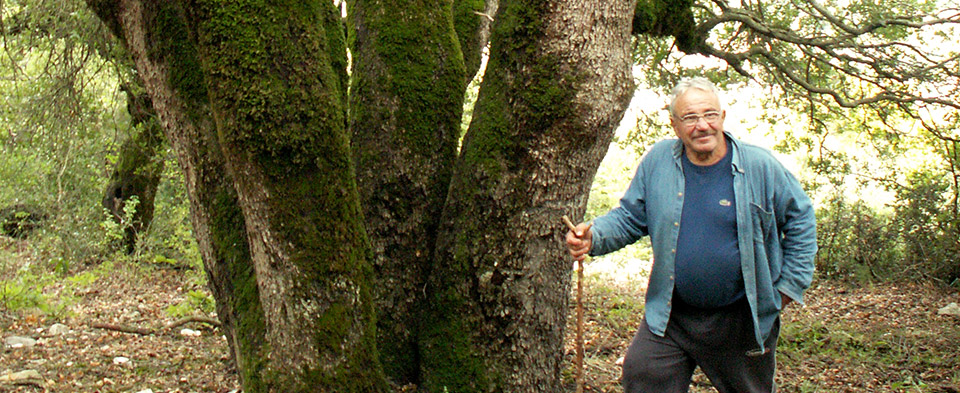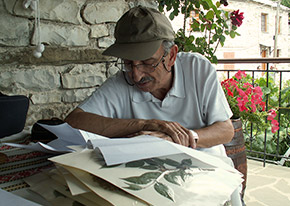Mae rhwydwaith o Safleoedd Naturiol Sacred i'w gael mewn Zarori, rhanbarth yn yr ardaloedd mynyddig Gogledd-orllewin Gwlad Groeg. Mae'r rhain yn goedwigoedd naill ai yn amddiffynnol neu llwyni ar lethrau mynydd uwchben pentrefi neu grwpiau o goed hynafol o amgylch capeli. Mae eu sylfeini ysbrydol a chynnal a chadw wedi cael eu dehongli fel ffordd o reoli adnoddau lleol ac ecosystemau drwy reolau crefyddol. Sacred trees and groves have been associated with taboos about tree cutting, for example relating to supernatural punishments. Yn y gorffennol, these locally adapted management systems regulated the use of ecosystem services by the community. They also served as a last resort in times of need or as a protection for the villages against natural hazards.
Dan Fygythiad; Tyfu fygythiad(s), may become endangered in the future, potential for significant loss exists.
During the 20th century and especially after the Second World War, changing patterns of land use and population decline have had a dramatic effect on the social structure, management practices and cultural landscapes of rural Greece. The collapse of local management systems was due to the coming of modernization and the indifference of centralized authorities. It has caused sacred groves to be degraded and threatened wherever they posed a conflict with modern demands. Despite this, sacred areas continue to be respected by local communities and they still constitute an important part of the older generation’s identity.
Ceidwaid
Mae'r rhan fwyaf o safleoedd sanctaidd yn y rhanbarth yn cael eu derbyn gofal gan y bobl leol. In the past Zarori was inhabited by the Zagorians who founded the villages and the linguistically distinct Vlachs. Pastoral transhuman Sarakatsani but also Gypsies and other migrants who were employed as labourers frequented the area. Shared traumas and population decline, especially in the 20th century, have eroded ethnic distinctions and today the “Zagorian” appellation incorporates all ethnic groups into an emerging identity defined by Zagori as a place of origin or habitation.
Mae pob trigolion yn Gristnogion Uniongred. Credoau am goed a llwyni cysegredig yn, Fodd bynnag,, gysylltiedig yn bennaf â cyn-Gristnogol syniadau. Mature trees for example, are seen as demonic creatures or as haunted by such beings and can thus damage those who try to harm them. Such local beliefs are either reinterpreted in the prevailing religion or coexist informally with it.
Gweledigaeth
Y dyddiau hyn tabws yn fading ynghyd â'r genhedlaeth hŷn. Mae elfennau o'r tabws wedi serch hynny, wedi'i gynnal drwy parch tuag at hanes cymuned a thraddodiadau. Our vision is that the Sacred Natural Sites are recognized as places of spiritual and historical value for the younger generations. We aim for that their cultural, aesthetic and ecological qualities are preserved and managed in an adequate way.
Sacred groves are little-known, even in modern Greece. The effort to survey them in Zagori started in 2003 ac mae wedi bod yn parhau ers gyda chymorth ariannol oddi wrth raglenni amrywiol y Weinyddiaeth Groeg yr Amgylchedd a'r UE. The University of Ioannina (UOI) has been involved since 2005. A new interdisciplinary project based at UOI “Conservation through Religion: the Sacred Groves of Epirus” (“SAGE”, 2012-2015) aims to study their biocultural value in the context of effective conservation. Mae cyfanswm o 38 Bydd gwyddonwyr cymdeithasol a naturiol o Wlad Groeg a thramor yn cymryd rhan. The local community has shown mainly positive interest in these efforts.
"Our religion is alive. I have seen Agia Paraskevi. She was shouting. I was a child of 16 mlynedd, late afternoon, it was raining. I was passing by above the monastery. And under the monastery some villagers had removed fallen tree branches from her Sacred Grove. And she was shouting: “Ei, ei” and the people left the wood and run away. I entered the church, nobody was inside. I made my cross and I continue my way. Evidently I have heard her." - Dimitris Paparounas (Resident in Ano Pedina village, interviewed in 18/9/2006.)
Ar lefel ranbarthol, darlithoedd cyhoeddus, cyhoeddiadau mewn cylchgronau lleol a gweithredu ar hen-coed rheoli wedi bod yn digwydd. Mae'r gweithgareddau hyn yn anelu at godi ymwybyddiaeth y cyhoedd am Safleoedd Naturiol Sacred a hen goed. Cysylltiadau diwylliannol lleol yn ymateb yn gadarnhaol iawn i syniadau hyn a mwy o ddigwyddiadau yn cael eu cynllunio ar gyfer y dyfodol agos.
Scientific work at a national and international level continues though participation in conferences, academic publications and cooperation with international Working Groups such as the IUCN (WCPA Cultural and Spiritual Values of Protected Areas Specialist Group) or the Menter Delos.
ers 2000, participatory techniques invented by social scientists, ethnobotanists and field ecologists have been used for the survey and mapping of Zagori’s sacred groves. 173 locals have participated in these studies. Most informants were older people. In the summer of 2009 1 photographic exhibition by Andre Bakker drew attention to the issue. These approaches are currently extended through the SAGE program, for example the survey of the biodiversity of the SNS, focusing on specific taxonomic groups (flora, adar, bats, lichens, fungi, insects).
Polisi a'r Gyfraith
Sacred groves in Greece, as in many other countries of the world form a largely unrecognized “shadow” conservation network. On the institutional level the Greek legislation, protects only 51 Natural Monuments concerning individual trees or groves with particular botanical, ecolegol, aesthetic, historical or cultural value. This leaves at least 99 % of the Greek Sacred Natural Sites officially unprotected. These monuments were declared as protected between 1972 a 1986, under the N.D. 86/1969 of the Forest Law, but because of changes in institutional level and the slow bureaucratic mechanism, any declaration of a Natural Monument faces long delays.
As a result of the ethnographic research, surveys and presentations many local representatives of villages’ cultural associations have approached this initiative asking for ways of increasing awareness and protection of the Sacred Natural Sites of their area. People also ask for practical advice to manage adequately the sacred veteran trees of their villages.
"In the past many people used to dedicate fields and vineyards to the Church. The old ladies who used to go to help in cultivation digging the vineyards were saying: “Shake your shoes so as not to take the sacred land with you”. Even the soil they did not want to take …That was respect, now the respect has gone." - †Athina Vlastou (1922-2010), resident in Dilofo village, interviewed in 10/7/2006.
- Kyriakidoy - Nestoros, A. (1989). Laografika meletimata (Astudiaethau Llên Gwerin) Rwy'n. Cymdeithas yr Archif Helenaidd Llenyddol a Hanesyddol, Athen [mewn Groeg].
- Lagopoulos, A.F. (2002). Mae'r lliain ouranos STI gi. Teletourgies kathagiasis Ellinikos paradosiakou oikismou Tou tous kai proelefsi (Yr awyr dros y Ddaear. Seremonïau sancteiddrwydd mewn aneddiadau traddodiadol Groeg ac mae eu tarddiad). Rhifynnau Odysseas, Athen [mewn Groeg].
- Nitsiakos, Yn. (2003). Choro kai Chtizontas mae'n Chrono (Adeiladu ar waith ac amser). Rhifynnau Odysseas, Athen [mewn Groeg].
- Hen, K., Tsiakiris, R. a Wong, J. (2012). Sacred coed a llwyni yn Zagori, Gogledd Pindos Parc Cenedlaethol, Gwlad Groeg. Yn: Pungetti, Gl., Oviedo, G., Hooke, D. (goln). Rhywogaethau Sacred a Safleoedd. Mae datblygiadau mewn Cadwraeth Biocultural. Cambridge University Press, U.K.
- Hen, K.,Tsiakiris, R. (2010). Mae'r "dolydd" a oedd yn "coedwigoedd": Achos y coedwigoedd amddiffynnol o Zagori, NW Gwlad Groeg, tt. 57-62. Yn: Sidiropoulou, A., Mantzanas, K., a Ispikoudis, Rwy'n. (goln). Trafodion y Panhellenic 7eg Rangeland Gyngres yn Xanthi, 14-16 Hydref 2010:"Gwyddoniaeth Ystod ac Ansawdd Bywyd". Weinyddiaeth yr Amgylchedd, Ynni a Newid yn yr Hinsawdd., Cyfarwyddiaeth Gyffredinol ar gyfer Datblygu a Warchod Coedwigoedd a'r Amgylchedd naturiol & Helenaidd pori a Bryniau Cymdeithas, Thessaloniki [mewn Groeg]: Gweld Gwefan
- Hen, K., Tsiakiris, R. (2010). Mae'r coed hynafol o Zagori fel mannau hanesyddol a symbolau sancteiddrwydd. Trafodion y Rhyngddisgyblaethol 6ed yn Metsovo, 16-18 Medi 2010: "Mae datblygiad integredig o ardaloedd mynyddig-ymchwil ryngddisgyblaethol, astudiaethau a chyfraniadau, yn gweithio, camau gweithredu, strategaethau, polisïau, ceisiadau, rhagolygon, potensial a chyfyngiadau ". Rhyng-prifysgol Cyngres Cenedlaethol Prifysgol Dechnegol (NTUA) a Center Metsovion y Ymchwil Rhyngddisgyblaethol (M.I.R.C.) y N.T.U.A: [mewn Groeg]. PDF
- Hen, K., Tsiakiris, R., Wong, J. (2009). Coed seciwlar a sanctaidd: Canfyddiadau o Coed mewn Zagori (Pindos Mynydd, Epirus, Gwlad Groeg). Yn: Saratsi, Mae'n. (a). Diwylliannau Coetir mewn Amser a Gofod, straeon o'r gorffennol y negeseuon ar gyfer y dyfodol, Cyhoeddiadau Embryo, Athen, Gwlad Groeg, tt. 220-227.
- Stiward, Ch. (1991). Gythreuliaid a'r Diafol. Dychymyg moesol mewn diwylliant Groeg Fodern. Princeton University Press, New Jersey.
- Dalkavoukis, Yn. (2001). Zagorisioi, Vlachoi, Sarakatsanoi, Gyftoi: ethnotopikes omades sto Zagori ton 20o aiona. [Zagorians, Vlachs, Sarakatsani, Gypsies: ethnic groups in Zagori in the 20th c.]. Unpublished PhD thesis, Aristotle University of Thessaloniki, Department of History and Archeology, Faculty of Contemporary and Modern History and Folkrore, Thessaloniki.







